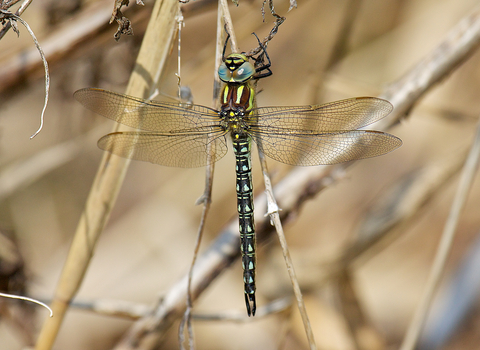
©David Martin
Hairy dragonfly
The UK's smallest hawker, the Hairy dragonfly is mostly black in colour, but has a distinctively hairy thorax. It can be found in grazing marshes and flooded gravel pits, and along canals from spring.
Enw gwyddonol
Brachytron pratensePryd i'w gweld
May to JulyGwybodaeth am rywogaethau
Ynghylch
The Hairy dragonfly is a medium-sized hawker found around waterbodies with plenty of different plants; ditches in grazing marshes, gravel pits and canals are particularly good spots to look for this species. The earliest dragonfly to emerge in the UK, it is on the wing from May to July. Hawkers are the largest and fastest flying dragonflies. They catch their insect-prey mid-air and can hover and fly backwards.Sut i'w hadnabod
The UK's smallest hawker, Hairy dragonfly is mostly black in colour. The male has pale blue, pear-shaped spots all along the body, blue eyes and broad, lime-green patches on the thorax. The female has yellowish spots and brownish eyes. If seen well, the short hairs all over the body make the Hairy dragonfly unmistakeable.Dosbarthiad
Found in small pockets of Southern and Eastern England, Wales, Scotland and Northern Ireland.In our area
The Hairy Dragonfly is a rare species in Montgomeryshire. There are a few records around Welshpool, but the Dyfi area appears to be the best place to see them. Keep your eyes peeled whilst visiting our Cors Dyfi Nature Reserve and let us know if you see one.
Roeddech chi yn gwybod?
The Hairy dragonfly was, until recently, a very rare species in the UK, found only on the most pristine grazing marshes and wetlands. It has recently expanded its range, possibly as a result of climate change.The Hairy Dragonfly is a rare species in Montgomeryshire. There are a few records around Welshpool, but the Dyfi area appears to be the best place to see them. Keep your eyes peeled whilst visiting our Cors Dyfi Nature Reserve and let us know if you see one.
